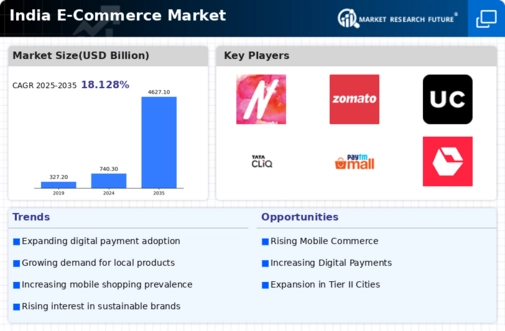Digital Payment Adoption
The rapid adoption of digital payment methods is a crucial driver for the e commerce market in India. With the increasing penetration of smartphones and internet connectivity, consumers are more inclined to use digital wallets, UPI, and other online payment systems. As of 2025, digital payments account for approximately 60% of all transactions in the e commerce market, reflecting a significant shift from traditional cash-based transactions. This trend is further supported by government initiatives promoting cashless transactions, which enhance consumer confidence in online shopping. The convenience and security offered by these payment methods are likely to continue driving growth in the e commerce market, as more consumers embrace the ease of making purchases online.
Changing Consumer Behavior
The evolving consumer behavior in India is significantly impacting the e commerce market. With a growing preference for online shopping, particularly among younger demographics, consumers are increasingly seeking convenience and variety. Surveys indicate that approximately 70% of consumers prefer online shopping for its ease and accessibility. This shift in behavior is driven by factors such as busy lifestyles, the availability of diverse product ranges, and the ability to compare prices effortlessly. As consumers continue to prioritize online shopping, the e commerce market is likely to experience sustained growth, prompting businesses to adapt their strategies to meet changing demands.
Rising Internet Penetration
India's internet penetration is a pivotal factor influencing the e commerce market. As of November 2025, over 700 million individuals have access to the internet, representing a penetration rate of around 50%. This widespread connectivity facilitates online shopping, enabling consumers from diverse backgrounds to engage with e commerce platforms. The increasing availability of affordable smartphones and data plans further fuels this growth, allowing even rural populations to participate in the digital economy. Consequently, the e commerce market is expected to expand as more users come online, creating new opportunities for businesses to reach untapped customer segments.
Government Initiatives and Policies
Government initiatives aimed at promoting digital commerce are playing a vital role in shaping the e commerce market in India. Policies such as the Digital India campaign and various tax reforms are designed to facilitate online business operations and encourage entrepreneurship. As of November 2025, the government has introduced measures to simplify compliance for e commerce businesses, which is expected to enhance market participation. These supportive policies not only foster a conducive environment for startups but also attract foreign investment, further propelling the growth of the e commerce market. The ongoing commitment to improving the regulatory framework is likely to yield positive outcomes for the industry.
Logistics and Supply Chain Innovations
Innovations in logistics and supply chain management are essential drivers of the e commerce market in India. Companies are investing in advanced technologies such as AI and machine learning to optimize delivery processes and enhance customer satisfaction. As of 2025, the logistics sector is projected to grow by 15% annually, driven by the increasing demand for efficient delivery services. Improved infrastructure, including warehouses and transportation networks, is also contributing to faster delivery times, which is a critical factor for consumers. These advancements are likely to bolster the e commerce market, as businesses strive to provide seamless shopping experiences.

























Leave a Comment